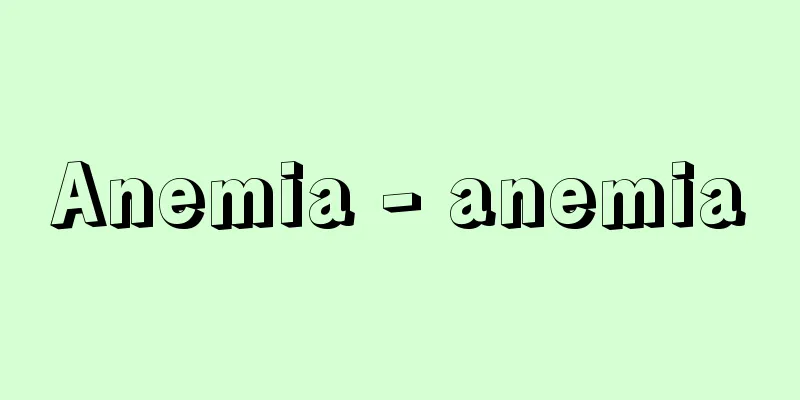Anemia - anemia

|
This refers to a state in which the number of red blood cells, or hemoglobin (also called hemoglobin, which accounts for one-third of the total weight of red blood cells), in a given volume of blood is reduced. The normal range is 4 to 5 million red blood cells per cubic millimeter and 12 to 16 grams of hemoglobin per deciliter. If the number of red blood cells is less than 3.5 million per cubic millimeter and the number of hemoglobin is less than 11 grams per deciliter, then anemia is definitely present. A decrease in hemoglobin reduces the gas exchange between oxygen and carbon dioxide, resulting in a decrease in oxygen in the tissues and a state of anemic hypoxia. A confusing condition is cerebral anemia, in which the amount of blood flowing through the brain is reduced, causing cerebral hypoxia and accompanied by a temporary loss of consciousness. If it is only in the brain, there is anemia because there is a decrease in blood, but if it is considered in the whole body, the red blood cells and hemoglobin are normal. Therefore, anemia is systemic, and ischemia caused by a decrease in local circulation is not considered anemia. [Kenjiro Ito] Causes and ClassificationThere are various causes of anemia, including a decrease in red blood cells and a decrease in the synthesis of hemoglobin in red blood cells. Red blood cell reduction can be caused by a decrease in red blood cell production in the bone marrow (aplastic anemia, narrowing of the hematopoietic area, pernicious anemia when immature erythroblasts cannot mature), increased destruction of red blood cells (hemolytic anemia), or loss of red blood cells due to bleeding (hemorrhagic anemia). In addition, red blood cells can be produced but the hemoglobin inside them cannot be produced due to iron deficiency anemia, thalassemia with abnormalities in the protein that makes hemoglobin, vitamin B6 deficiency, sideroblastic anemia caused by a deficiency of the enzyme delta-aminolevulinic acid (ALA), as well as a deficiency of transferrin, which transports iron, and lead poisoning. In addition to the above classification of anemia according to the mechanism of onset, there is also a classification based on red blood cell index, which has been used for some time. This is based on the pigment index, mean volume, mean hemoglobin amount, and mean hemoglobin concentration, and is calculated from hemoglobin, red blood cells, and hematocrit (red blood cell volume percentage). (1) Microcytic hypochromic anemia This type of anemia is caused by impaired hemoglobin synthesis. (2) Macrocytic hyperchromic anemia This type of anemia is caused by impaired maturation of erythroblasts. (3) Normocytic normochromic anemia This type of anemia occurs when the production of red blood cells, including erythroblasts, is reduced, or when the anemia is caused by hemolysis or bleeding. Secondary anemia also occurs. According to this classification, (1) and (2) are representative diseases caused by iron deficiency anemia, vitamin B12 deficiency anemia, and folic acid deficiency anemia, while (3) is representative of aplastic anemia, malignant blood disease, hemolytic anemia, and secondary anemia. (1) and (2) are easily cured by replenishing the deficient substances, while (3) is a group of anemias that are not easily cured, making this a convenient classification method that also allows you to know the prognosis of anemia. Secondary anemia is anemia that appears as part of the symptoms of another disease, and its onset mechanism is a combination of the above-mentioned causes. [Kenjiro Ito] SymptomsAnemia causes oxygen deficiency in all organ tissues, so all organs function poorly, but the organs that consume a lot of oxygen tend to show symptoms first. Such organs include the central nervous system (brain), cardiac muscle, respiratory system (lungs), digestive system (stomach and intestines), and reproductive system (ovaries), and during exercise, the muscles of the entire body also participate. Therefore, symptoms include headaches, heavy head, dizziness, tinnitus, decreased attention, decreased concentration, somnolence (strong sleepiness), decreased memory (memory of experiences that are very recent in time), palpitations, angina-like chest pain, difficulty breathing, shortness of breath, loss of appetite, diarrhea, constipation, emaciation (morbid thinness), irregular menstruation, fatigue, lethargy, stiff shoulders, and even edema, a decrease in minimum blood pressure, the expansion of the heart causing murmurs, and murmurs can be heard in the veins. The face becomes pale, the mucous membranes also become pale, and the bright red of the lips disappears. When anemia progresses slowly, the body gets used to it and adjusts, so the symptoms are mild, and there are cases where people can continue to work normally even when their red blood cell count falls below 2 million. However, palpitations, difficulty breathing, chest pain, etc. always appear when exercising, walking, climbing stairs, etc., and even if you stop exercising, your condition will not return to normal as quickly as in healthy people, and it will take time to recover. When a large amount of blood is lost at once, acute hemolytic anemia occurs, and blood plasma is expelled from the blood vessels along with blood cells, causing the blood vessels to collapse, blood pressure to fall, the pulse to become slow and frequent, consciousness to become clouded, and then to disappear, leading to coma and eventually death. Generally, when one-third of the total blood volume (1,000-1,500 milliliters) is lost at once, anemic shock (the above symptoms occur severely) occurs, putting the patient's life at risk. If bleeding continues chronically in small amounts, red blood cells are produced to replenish the blood, making anemia less likely to occur, but red blood cells in the blood contain iron (1 milliliter of red blood cells is equivalent to 1 milligram of iron), and the body gradually becomes deficient in iron, eventually resulting in iron deficiency anemia. [Kenjiro Ito] Iron deficiency anemiaIron is an essential substance for the synthesis of heme in hemoglobin, and its deficiency causes microcytic hypochromic anemia. The iron contained in food, 10 to 20 milligrams, is ionized during digestion in the stomach, absorbed mainly in the duodenum, and then bound to transferrin for transport. It is mainly used in the bone marrow for the synthesis of hemoglobin, and some is also used for the synthesis of myoglobin and heme enzymes in muscles, and the excess is stored. About 1 milligram per day is then excreted from the body mixed with nails, hair, and epithelial cells that are exfoliated. In addition to losing a large amount of iron when bleeding, about 1,000 milligrams (almost the same amount as stored iron) are lost each time pregnancy, childbirth, and breastfeeding occur. In addition, the need for iron increases during puberty due to the promotion of hematopoiesis accompanying physical growth. Iron deficiency is related to the metabolism of iron and the increased demand for iron, and women from puberty to menopause are particularly prone to iron deficiency due to menstruation. In both men and women, important causes of iron deficiency are bleeding from cancer, ulcers, and hemorrhoids, and in women, uterine fibroids are a common cause. Iron deficiency anemia is chronic anemia, and in addition to the symptoms of anemia mentioned above, symptoms of iron deficiency are also present. Symptoms of iron deficiency asthenia include a strong feeling of weakness, lethargy, and fatigue, flat and brittle nails and spoon-shaped deformation due to heme enzyme deficiency, erosion of the corners of the mouth, white hair, and painful swallowing due to abnormalities in the mucous membranes of the pharynx, tongue, and esophagus entrance, and caution is required as these symptoms can appear even without anemia, even with iron deficiency alone. To make a diagnosis, the nature of the anemia is examined and serum iron, transferrin, and ferritin (stored iron) are measured for reference. There will be a significant decrease in serum iron, an increase in transferrin, and a significant decrease in ferritin. [Kenjiro Ito] Pernicious anemiaThis is macrocytic hyperchromic anemia caused by vitamin B12 and folic acid deficiency. Vitamin B12 is found in animal foods, binds with intrinsic factor in gastric juice, is absorbed in the ileum, binds with transcobalamin and is transported through the body, and cooperates with folic acid to help the division and maturation of somatic cells. It is also essential for the metabolism of nervous tissue. If there is a deficiency of intrinsic factor in gastric juice, if the stomach is completely removed, if consumption increases due to pregnancy, or if it is consumed by intestinal bacteria, it becomes deficient and causes anemia. In this case, the number of white blood cells and platelets also decreases. The bone marrow is filled with large red blood cells (megaloblasts) and granulocytes (giant neutrophils) that cannot divide and mature. In this case, it is also called megaloblastic anemia. In addition, the spinal cord is affected, making it impossible to walk, and brain cells degenerate, resulting in mental symptoms. Symptoms include atrophy of the tongue mucosa, glossitis (hunter's tongue), indigestion such as diarrhea, complete loss of hydrochloric acid in the stomach, white hair, jaundice, and a tendency to bleed. Folic acid is found in large amounts in green vegetables and is absorbed by the small intestine. Deficiency is rare, but can be seen in alcoholics and those with malabsorption, and pregnancy is also prone to deficiency. Apart from the lack of neurological symptoms, it is similar to vitamin B12 deficiency, but whereas B12 deficiency occurs in the elderly, folic acid deficiency can occur in all age groups. [Kenjiro Ito] Hemolytic anemiaIt occurs when red blood cells cannot maintain their 120-day life span and break down. There are many causes, including congenital production of spherocytocytes or oval red blood cells, congenital deficiency of red blood cell enzymes, acquired production of red blood cell antibodies, exposure to blood toxins, abnormalities in the heart or blood vessels, abnormal hemoglobinemia, and burns. The most common causes are hereditary spherocytosis and acquired autoimmune hemolytic anemia. Hemolytic jaundice can occur together with anemia, and congenital cases begin to show symptoms during elementary and junior high school years, are accompanied by splenomegaly, and are often accompanied by gallstones. [Kenjiro Ito] Aplastic anemiaThis is an incurable anemia, caused by a decline in the bone marrow's hematopoietic function, resulting in a decrease in the total blood cell count. [Kenjiro Ito] Secondary anemiaRenal anemia, which belongs to this category, is anemia that is parallel to the severity of uremia and is thought to occur due to the cessation of erythropoietin production. Other types of anemia include those associated with rheumatic diseases, infectious diseases, endocrine disorders, and malignant tumors. [Kenjiro Ito] Childhood anemiaUnlike adults, children grow rapidly during childhood, but the functions of each organ are incomplete, making them susceptible to all kinds of influences, and they are prone to anemia. The types and mechanisms of anemia are the same as in adults, but the conditions that are common in adults are rare in children. Also, the blood picture becomes the same as in adults during school age, and before that, the ratio of granulocytes to lymphocytes is different. Anemia specific to children includes dietary anemia caused by a long period of breastfeeding, childhood pseudoanemia (pallor caused by blood vessel constriction), Fanconi anemia (a congenital disease accompanied by morphological abnormalities), and genetic blood disorders can develop during school age. [Kenjiro Ito] TreatmentTreatment for anemia varies depending on the cause. For iron deficiency, vitamin B12 deficiency, and folic acid deficiency, the deficiency is replenished and continued until sufficient stores are built up to prevent recurrence. Adrenal cortical hormones and immunosuppressants are used for antibody-induced anemia, and removal of the spleen is essential for hereditary spherocytosis. For anemia with no cure, blood transfusions are used, but these should be kept to a minimum, and it is best to use only red blood cells that are free of white blood cells or platelets. Excessive blood transfusions reduce hematopoietic function and can also result in an overdose of iron. [Kenjiro Ito] [References] | | | | |Source: Shogakukan Encyclopedia Nipponica About Encyclopedia Nipponica Information | Legend |
|
血液の一定容積中の赤血球つまりはヘモグロビン(血色素ともいい、赤血球全重量の3分の1を占める)が減少している状態をさす。正常範囲は、赤血球は1立方ミリメートルに400万~500万個、ヘモグロビンは1デシリットル中に12~16グラムである。赤血球が1立方ミリメートル中350万個以下、ヘモグロビンが1デシリットル中11グラム以下であれば確実に貧血といえる。ヘモグロビンの減少により酸素と二酸化炭素のガス交換が低下するため、組織では酸素が減少して貧血性の低酸素状態となる。紛らわしいものに脳貧血という状態があるが、これは、脳を流れている血液量が減少して脳の低酸素症をおこし、一過性の意識障害を伴う。脳だけについていえば血液が少なくなっているので貧血であるが、体全体からみれば赤血球、ヘモグロビンは正常である。したがって、貧血は全身的なもので、局所的な循環の低下による虚血は貧血とはいわない。 [伊藤健次郎] 原因・分類貧血にはいろいろな原因があるが、赤血球が減少する場合と、赤血球内に含まれているヘモグロビンの合成が低下する場合とがある。赤血球が減少する原因としては、骨髄内で赤血球の産生が低下する場合(再生不良性貧血、造血面積の狭小化による場合、幼若赤芽球の成熟ができない場合としての悪性貧血)、赤血球の破壊が亢進(こうしん)した場合(溶血性貧血)、出血で赤血球を失った場合(出血性貧血)などがある。また、赤血球がつくられても、中のヘモグロビンがつくられない場合としては、鉄が不足した鉄欠乏性貧血、ヘモグロビンをつくっているタンパク部分に異常があるサラセミア、ビタミンB6の欠乏、δ(デルタ)‐アミノレブリン酸(ALA)合成酵素の欠乏によっておこる鉄芽球性貧血、さらに、鉄を運搬しているトランスフェリンの欠乏症、鉛中毒などがある。 貧血にはこのような発生機序別の分類があるが、このほかに、以前から用いられている赤血球係数による分類がある。これは、色素指数、平均容積、平均ヘモグロビン量、平均ヘモグロビン濃度によるもので、ヘモグロビン、赤血球、ヘマトクリット(赤血球容積率)から計算される。(1)小球性低色素性貧血 血色素合成障害による貧血がこれに属する。(2)大球性高色素性貧血 赤芽球の成熟障害による貧血がこれに属する。(3)正球性正色素性貧血 赤芽球を含めて赤血球の産生が低下する場合、溶血による場合、出血による場合がこれに属する。また続発性貧血もこれに属する。 この分類によると、(1)と(2)は鉄欠乏性貧血と、ビタミンB12および葉酸欠乏性貧血、(3)は再生不良性貧血、悪性血液疾患、溶血性貧血、続発性貧血などが代表的疾患である。(1)と(2)は欠乏物質の補給で容易に完治するもの、(3)は簡単には治らない貧血群であり、貧血の予後までわかる都合のよい分類法である。なお、続発性貧血というのは、他に疾患があって、その症状の一部として現れた貧血のことで、発生機序は前記のものが複合して原因となっている。 [伊藤健次郎] 症状貧血は全身の臓器組織の酸素欠乏であるために、どの臓器も機能が低下するが、とくに酸素消費の多いところが先に症状として現れやすい。そのような臓器は中枢神経(脳)、心筋、呼吸器(肺)、消化器(胃腸)、生殖器(卵巣)などで、運動時には全身の筋肉も参画する。したがって、頭痛、頭重、めまい、耳鳴り、注意力低下、集中力低下、傾眠(強い眠気)、記銘力(時間的にごく近い体験の記憶力)低下、心悸亢進(しんきこうしん)(動悸)、狭心症様の胸痛、呼吸困難、息切れ、食欲不振、下痢、便秘、るいそう(病的にやせる)、生理不順、疲労、倦怠(けんたい)、肩こり、そしてさらに浮腫(ふしゅ)が出やすくなり、最低血圧が下降し、心臓が拡張して雑音が出現し、静脈でも雑音が聞かれるようになる。顔は蒼白(そうはく)、粘膜も蒼(あお)白く、唇の鮮やかな赤みが消失する。貧血がゆっくり進行するときは、体がそれに慣れて順応していくために、自覚症状は軽く、赤血球が200万個以下になっても、普通に仕事をしている例もある。しかし、運動時、歩行時、階段を昇るときなどには、かならず動悸とか呼吸困難、胸痛などが出現し、運動を停止しても健康者のように速やかに元に戻ることはなく、回復するのに時間がかかる。 血液が一時に大量に失われると急性失血性貧血をおこし、血球とともに血漿(けっしょう)も血管外に出てしまうために、血管が虚脱に陥って血圧が低下し、脈拍が小さく頻数となり、意識が混濁からさらに消失して昏睡(こんすい)になり、やがては死亡する。一般に全血液量の3分の1(1000~1500ミリリットル)が一時に失われると、貧血性ショック(前記の症状が激しくおこる)をおこして生命が危険となる。慢性的に少量ずつ出血が続いている場合は、それに対応して赤血球がつくられ補給されるので貧血はおこりにくいが、血液中の赤血球には鉄分が含まれており(1ミリリットルの赤血球は1ミリグラムの鉄に相当する)、漸次体内の鉄が欠乏して、ついには鉄欠乏性貧血が発生することになる。 [伊藤健次郎] 鉄欠乏性貧血ヘモグロビンのヘムをつくるために鉄は必須(ひっす)の物質であり、その欠乏は小球性低色素性貧血の原因となる。食品中に10~20ミリグラム含まれている鉄分は、胃内の消化でイオン化され、おもに十二指腸で吸収されたのち、トランスフェリンに結合して運ばれる。おもに骨髄でヘモグロビン合成に用いられるほか、一部は筋肉のミオグロビン、ヘム酵素の合成にも用いられ、不必要な分は貯蔵される。そして1日に1ミリグラムぐらいが、爪(つめ)、毛髪、剥離(はくり)する上皮細胞などに混じって体外に出ていく。出血があると、大量の鉄を喪失するほか、妊娠、分娩(ぶんべん)、授乳を経験するたびに約1000ミリグラム(貯蔵鉄量とほぼ同量)が失われる。また、思春期には体の成長に伴う造血促進により鉄の必要量が増加する。このような鉄の代謝、需要量の増加などに関係して鉄分が欠乏するが、とくに思春期から閉経期までの女性は月経に伴う鉄欠乏に傾きやすい。また、男女ともに原因として重要なものは、癌(がん)、潰瘍(かいよう)、痔(じ)などからの出血で、女性では子宮筋腫が原因になりやすい。鉄欠乏性貧血は慢性の貧血で、前述の貧血の症状が現れるほかに、鉄の欠乏のための症状が加わる。鉄欠乏性無力症として、強い無力感、倦怠感、疲労感があり、ヘム酵素欠乏のために爪の扁平脆弱(へんぺいぜいじゃく)化、スプーン様の変形がみられ、口角のびらん、白毛のほか、咽頭(いんとう)、舌、食道入口部の粘膜の異常による嚥下(えんげ)痛などが特有で、これらは貧血がなくても鉄欠乏のみでも出現するので注意を要する。診断には、貧血の性質をみて、血清鉄、トランスフェリン、フェリチン(貯蔵鉄)を測定して参考にするが、血清鉄の著減と、トランスフェリンの増加、フェリチンの著減がみられる。 [伊藤健次郎] 悪性貧血ビタミンB12、葉酸の欠乏によっておこる大球性高色素性貧血である。ビタミンB12は動物性食品中に含まれ、胃液中の内因子と結合してから回腸で吸収され、トランスコバラミンと結合して体内を運ばれ、葉酸と協力して体細胞の分裂成熟に役だっている。また、神経組織の代謝に必須のものである。胃液中の内因子が欠乏したり、胃を全部切除したり、あるいは妊娠などで消費が増加した場合、または腸内細菌によって摂取され尽くしたりすると、欠乏して貧血をおこす。この際は白血球も血小板も減少する。骨髄の中は、分裂成熟のできない大きい赤芽球(巨赤芽球)や顆粒(かりゅう)球(巨大好中球)などで満たされる。この場合は巨赤芽球性貧血ともいわれる。そのほか、脊髄索(せきずいさく)が冒されて歩行ができなくなったり、脳細胞が変性して精神症状が現れる。舌粘膜が萎縮(いしゅく)して舌炎(ハンター舌)、下痢などの消化不良、胃の塩酸が完全に消失し、白毛、黄疸(おうだん)、出血傾向を伴う。葉酸は緑色野菜に多く含まれ、小腸から吸収される。欠乏することはまれであるが、アルコール中毒者、吸収不全症などでみられることがあり、また妊娠時にも欠乏しやすい。神経症状を欠くほかはビタミンB12欠乏と同様であるが、B12欠乏は高齢者におこるが、葉酸欠乏は全年代におこりうる。 [伊藤健次郎] 溶血性貧血赤血球が120日の寿命を保てないで崩壊するためにおこる。その原因は多いが、先天的に球状赤血球や楕円(だえん)赤血球をつくるもの、また先天的に赤血球酵素の欠乏した場合、後天的に赤血球抗体ができた場合、血液毒が作用した場合、心臓とか血管に異常のある場合、異常血色素症、やけどなどである。もっとも多いのは遺伝的球状赤血球症と、後天的自己免疫性溶血性貧血である。貧血とともに溶血性黄疸を併発し、先天性のものは小・中学生時代から症状が現れ、脾腫(ひしゅ)を伴い、胆石の合併が多い。 [伊藤健次郎] 再生不良性貧血骨髄の造血機能が低下して全血球数が減少する、治りにくい貧血である。 [伊藤健次郎] 続発性貧血これに属する腎(じん)性貧血は尿毒症の程度と並行した貧血で、エリスロポエチンの産生が停止したためにおこると考えられる。ほかに、リウマチ性疾患、感染症、内分泌異常、悪性腫瘍(しゅよう)などに伴うものがある。 [伊藤健次郎] 小児貧血小児期は成人と異なって、急激な成長が行われているが、各臓器の機能は不完全で、すべてにわたって影響を受けやすく、貧血も発生しやすい。貧血の種類や発生機序は成人と変わらないが、成人に発生しやすいものは小児ではまれである。また成人と同じ血液像になるのは学童期で、それ以前は顆粒球、リンパ球の比が異なる。小児特有の貧血に、長すぎる授乳期間による食事性貧血とか、小児仮性貧血(血管の収縮による蒼白)、ファンコニー貧血(形態異常を伴う先天的疾患)などがあり、また、遺伝的血液疾患は学童期から発病してくる。 [伊藤健次郎] 治療貧血の治療法は原因によって異なる。鉄欠乏、ビタミンB12欠乏、葉酸欠乏にはそれぞれ欠乏したものを補給し、十分貯蔵ができるまで続けて再発を防ぐ。副腎皮質ホルモン、免疫抑制剤は抗体による貧血に用いられ、脾臓の摘出は遺伝性球状赤血球症に絶対必要である。根治療法のない貧血には輸血療法を行うが、必要最小限にとどめ、また、白血球や血小板の混じらない赤血球だけを用いるのがよい。過剰の輸血は造血機能を低下させる一方、鉄分の過剰投与になる。 [伊藤健次郎] [参照項目] | | | | |出典 小学館 日本大百科全書(ニッポニカ)日本大百科全書(ニッポニカ)について 情報 | 凡例 |
Recommend
Ukrainian Catholic Church
...Of these, 3.9 million were civilians, of which...
concilia
…The Spartan assembly voted with shouts of approv...
Massimo d'Azeglio
1798‐1866 Italian politician. In his youth he aspi...
Buda
…the capital of Hungary. Its correct name is Buda...
Raumkunst; Spatial arts
Art that uses space as a place of expression, such...
Child psychiatry
Psychiatry for children and school-age children. C...
Society - Shashoku
An ancient Chinese national ritual. Compared to t...
Freeloader - Isourou
A lodger is an idle roommate, and the same goes f...
Cupboard
A type of cupboard. Since board was used as a syno...
Sheep spot - Yohan
They are also called floccules or chromospheric wh...
Class value - Kaikyuchi
The median value of each class when the distributi...
Department of Physical Medicine
A medical department that uses the physical effect...
Nakamura Kanzaburo
Headmaster of the Nakamuraza Kabuki theater in Ed...
"The Moon Leaking from the Weaving Palace" - Orido no Ki Morutsuki
...The first link between Yamauba and the world o...
Medical aircraft - medical aircraft
…Hospital ships were most active during World War...









